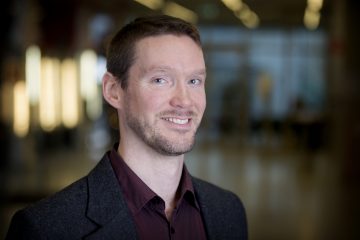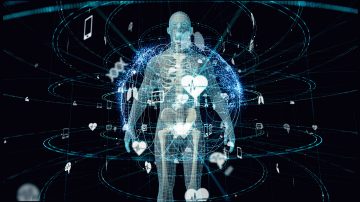AI NYTT. We can use artificial intelligence for many things, including for organizing otherwise unmanageable amounts of data or developing software that helps in interpreting information-rich high-resolution x-ray images. In order to assist Sahlgrenska Academy researchers in staying up-to-date on this fast-developing field, management has appointed Justin Schneiderman to serve as an AI advisor for the faculty.
In recent years, both competence and infrastructure for AI have taken great steps forward, among other things through the initiatives AI Sweden and Chalmers AI Research Center, Chair.

“The opportunities to conduct AI research in Gothenburg are excellent, and at Sahlgrenska Academy we must be careful to create good conditions for researchers and teachers to apply AI methodology in their research and teaching. Justin Schneiderman has great interest and knowledge in the field, and we are extremely pleased that he has accepted the assignment to help employees stay up to date and well informed about AI”, Vice Dean Henrik Hagberg comments.
“AI is an exciting area that is incredibly promising for the future. While it may not live up to all of the hype, it will clearly be a powerful tool for many people working in healthcare,” says Justin Schneiderman.
Justin is a senior lecturer in experimental multimodal neuroimaging and associate professor in experimental clinical neurophysiology. He is based at MedTech West and affiliated with Chalmers as a researcher in quantum device physics.
Enormous amounts of data
The only way for the health and medical care system as well as medical researchers to process the huge—and growing—volumes of data generated on patients is through development and implementation of technical solutions. Imaging is one example where new technologies result in increasingly high resolutions, both spatially and temporally.

“If we can interpret these huge amounts of data, we could potentially develop preventive methods, where we can predict risk before a negative health outcome develops. AI then becomes a tool that can boil down the data into something useful.”
Lots of AI activity
There are already many AI-related activities involving researchers at Sahlgrenska Academy. SCAPIS is, for example, an enormous project where researchers are using AI to find relevant aspects of large amounts of data collected from each test subject, such as x-ray and MR images, genetic information, and register data. There are also smaller studies that include AI, such as a project examining variations in heart rate that links these to the risk of stroke and another project analyzing patient records to identify words and patterns that can support early diagnosis of lung cancer.
Collaboration is key
Since AI software must be created based on the conditions for each project, networks and interdisciplinary collaboration are required.
“At this point, everyone knows that AI is important, but many are asking what has already been done, what is possible, and what they need to do to get started. My job is to help highlight interesting activities and projects, as well as meetings or other events, within AI to increase awareness and inspire efforts.”
Under the heading AI Nytt, Justin will be highlighting information and news about artificial intelligence that can be useful for staff at Sahlgrenska Academy. Information will also be collected on a page on Sahlgrenska Academy’s website in the Staff Portal (link to come shortly).
Postdoc at Chalmers

In his own research, Justin contributes to developing new technology for measuring brain activity. This involves a more sensitive sensor technology for magnetoencephalography (MEG). Physicists researching superconducting components collaborate in the project with, among others, brain researchers in neuroscience and physiology. He is also working on installing a new research laboratory at Sahlgrenska University Hospital to develop clinical applications of MEG, magnetocardiography, and microwave-based hyperthermia. This facility will be available to all researchers at SA that are interested in these techniques.
Justin is a physicist by training but has also completed the biology and medical courses American students take when planning to study medicine. During his undergraduate studies, he became interested in quantum computers, in particular their potential to solve complex medical problems. His doctoral thesis at the University of Southern California in Los Angeles explored superconducting quantum technology with Chalmers professor Per Delsing as his assistant supervisor. A postdoc at Chalmers with Professor Dag Winkler brought him to Gothenburg, and in 2010 he was one of the first researchers hired by Sahlgrenska Academy at MedTech West, the collaborative platform started by Chalmers, the University of Gothenburg, the University of Borås, as well as Sahlgrenska University Hospital and the Region Västra Götaland.
TIP! The University of Helsinki offers a free online course, open to everyone, that teaches the basics of artificial intelligence. The course is called Elements of Artificial Intelligence: https://www.elementsofai.com/.
TEXT: ELIN LINDSTRÖM










